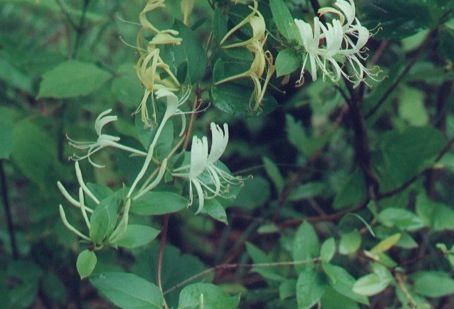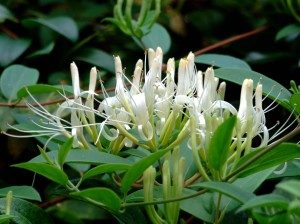
Some Honeysuckles are edible, some are toxic
Lonicera japonica: Sweet Treat
The honeysuckle family is iffy for foragers. It has edible members and toxic members, edible parts, toxic parts, and they mix and match. Some are tasty, some can stop your heart. So you really have to make sure of which one you have and which part is usable and how.
On the top of the common list is the Japanese Honeysuckle. It is the honeysuckle kids grew up with, picking the flowers for a taste of sweetness. Young leaves are edible boiled. In my native state of Maine there is the L. villosa, the Waterberry, some times called the Mountain Fly Honeysuckle, with edible berries. It is also sometimes mistakenly called L. caerulea (which is European.) Let me see if I can clear that up: If it refers to L. caerulea as edible it is usually L. villosa which is actually being identified (Waterberry.) If it is L. caerulea and toxic it is usually the L. caerulea in Europe that is being referred to. How the L. villosa in North America got referred to as L. caerulea is anyone’s guess. Anyway, the Waterberry berries are quite edible.
Among the edible are: L. affinis, flowers and fruit; L. angustifolia, fruit; L. caprifolium, fruit, flowers to flavor tea; L. chrysantha, fruit; L. ciliosa, fruit, nectar; L. hispidula, fruit; L. involucrata, fruit; L. kamtchatica, fruit; L. Japonica, boiled leaves, nectar; L. periclymenum, nectar; L. utahensis, fruit; L. villosa, fruit; L. villosa solonis, fruit;
Among those that might be edible or come with a warning of try carefully are: L. canadensis, fruit; L. Henryi, flowers, leaves stems; L. venulosa, fruit.
There are about 180 species of honeysuckle, most native to the northern hemisphere. The greatest number of species is in China with over 100. North America and Europe have only about 20 native species each, and the ones in Europe are usually toxic. Taste is not a measure of toxicity. Some Lonicera have delicious berries that are quite toxic and some have unpalatable berries that are not toxic at all. This is one plant on which taste is not a measure of edibility. Properly identify the species.
Species in the genus are quite consistent. The leaves are opposite, simple, oval. Most loose their leaves in the fall but some are evergreen. Many have sweetly-scented, bell-shaped flowers with a sweet, edible nectar. The fruit can be red, blue or black berry, usually containing several seeds. In most species the berries are mildly poisonous, but a few have edible berries.
While the flowers are a popular nectar source for bees and butterflies L. japonica is considered an invasive weed throughout the warmer parts of the world, from Fiji to New Zealand to Hawaii. It was introduced to the United States about 200 years ago and because it has no natural enemies here has been spreading ever since. In my own yard it has proven to be very invasive, not only up but out. I’ve had a several year battle with it trying to cover a pear tree and a grape arbor.
Lonicera japonica is pronounced lah-NISS-ser-ruh juh-PAWN-nick-kuh. The genus was named after Adam Lonitzer (1528-1586) a German physician and botanist. Japonica means of Japan
Green Deane’s “Itemized” Plant Profile
IDENTIFICATION: Lonicera japonica: A vine to 80 feet, twining, trailing, thin, sometimes rooting at nodes, reddish to brownish or purplish, younger parts hairy, often with thin woody bark on the lower stems. Leaves – opposite, with stems or without, leaves variously hairy above and below but typically densely hairy, no teeth, ovate-oblong, pointed tip, rounded to heart-shaped at base. Flowers white, drying to yellow, a tube, upper lip 4-lobed, bottom lip single-lobed, Stamens 4, filaments hairless, white, style white, stigma green. Fruits black, fleshy globes, not edible.
TIME OF YEAR: Leaves when in season, flowers May to July in northern climes, nearly year round where it is warm
ENVIRONMENT: Landscaping, naturalized in open woods, thickets, roadsides, railroads
METHOD OF PREPARATION: Nectar sucked off the ends of the flowers, young leaves boiled. In China leaves, buds and flowers are made into a tea but the tea may be toxic. Proceed carefully.




Suggestion: Consider devoting space on your website to pictures of “weeds” you have further information about on your website. I see weeds as I am outdoors that I know I have seen on your site but do not know their name and thus cannot go back and do further investigation. The only way for me to find out what they are is to go through your videos one by one until I find the right one. This is very time consuming. If I had a picture to reference I could then search your site for further information. JUST A SUGGESTION. Do not feel the need to respond unless you would like to. THANKS AGAIN FOR ALL THE WONDERFUL EDUCATION!!!
Dear Joan,
I agree. Pictures would be more helpful. Thanks for the suggestion.
can you tell me if coral honeysuckle ( lonicera sempervirens ) is toxic or has toxic parts to it ? That is, if it is toxic to humans or chimpanzees.
I have no evidence that it is edible.
The leaves are edible at least as medicine. No idea in what quantity. First hand, I can tell you the leaves taste a bit like wheatgrass and have an analgesic effect in the mouth and throat, so it is good for a sore throat. “leaves ground by chewing and applied to bee stings. (Weiner) Leaves make a decoction for sore throats and coughs.” – https://www.wildflower.org/plants/result.php?id_plant=LOSE. No information on blossoms or berries or any other part of the plant. Jill Nokes book on growing plants in the southwest has some information but I don’t have it handy.
Actually an herbal “decoction” requires boiling, so I don’t have any reputable information on whether the leaves would be edible and non-toxic raw, though I have eaten them. So we should not be eating them unless we have made a decoction. 🙂
https://plants.ces.ncsu.edu/plants/all/lonicera-sempervirens/ says the berries are inedible
Hey deane, in all my research I’d never heard of L. ciliosa having edible berries. Do you have a source for that?
Native American Food Plants by Daniel Moerman pp 145. 2010 edition.
I have honeysuckle blooming in my backyard and was researching ways to use it. How do I determine what species it is? I wanted to try making jelly with the blossoms, but now I’m a little apprehensive about doing that.
There are a lot of variations. Best to get a local to do it,or you can try posting some pictures of it on the UFO page of the Green Deane Forum.
Hi~ I was very excited to make Honeysuckle Jelly and then I was informed that some varieties are poisonous I had no idea.. and that was after I tried it :/ So how do I identify which type is which I was just using the nectar… not the berries
Thank You
It’s telling me I’ve sent this comment already, but it’s still sitting here in the comment box. Forgive me if it’s a duplicate! I hope it’ll send it this time.
Is the calyx/ovary of the L. japonica toxic at all? In other words, must it be removed before using the flowers?
I’m asking because the jelly recipe I found (in various places) says to cut them off, and I did so. But pictures I see of other recipes seem to show the calyx still on, and the recipes do not mention cutting it off. I can find no other information.
Removing the calyx from every flower is very time consuming!
I finally found my answer! You do not have to cut the calyx/ovary off of the base of the flower.
From Chef Bill Smith of Crook’s Corner, where he makes a honeysuckle sorbet every summer which is a local favorite (and has a recipe for jelly, too):
” …Avoid ones that are dark yellow or shriveled as they may be bitter, and for goodness sake, don’t bother pinching off the tiny green bases.
“Some people think I actually do that at the restaurant, or use just the stamens because that’s their childhood experience with honeysuckles,” Smith says with a chuckle. “If I did that, I’d never get around to making anything.”
http://www.chapelhillmagazine.com/dining/crook%E2%80%99s-inspired-honeysuckle-jelly-two-ways/
New info, see #7, on edibility of coral honeysuckle
https://www.tyrantfarms.com/incredible-edible-wild-flowers/?utm_source=Tyrant+Farms&utm_campaign=e4c3cd22cf-RSS_EMAIL_CAMPAIGN&utm_medium=email&utm_term=0_cbf9ba8474-e4c3cd22cf-115733693
Why do they call it “fly” honeysuckle?
Yes I eat the ones at the top I break out. In. Hives. Did I eat wrong ones?
I’m sorry, but without pictures the text doesn’t mean much more than some honeysuckles are toxic and some aren’t. But thank you anyway; I had no idea some honeysuckle were toxic. I do appreciate your mentioning most toxic honeysuckle are in Europe.
There are pictures.
You have to do some of your own homework. Google the latin names or look them up on good botanical plant websites…you should find images and information to help you identify or at least compare species. Trying to include all of that here would be tough. If photos of the edible species were included but not the inedible or toxic ones, that might encourage people to make mistakes and fail to properly identify what they have.
What is the latin name for the honeysuckle vine that has long (2 in.) pink/orange flowers and round lily pad leaves? What parts of it are toxic….and what are the toxic effects. I have such a plant, but do not know the name of it…..I would greatly appreciate your helpful response!
Sounds like you are talking about the “Lonicera Magnifica”. The berries are only edible to wild birds.
Tecoma capensis is NOT edible.
Hi there! I have lonicera maackii growing in my backyard. The berries are beautiful and juicy looking and I am tempted to try them. I have read that lonicera maackii is an asian invasive. Do you think the berries are edible? Thanks in advance!
They are toxic, do not eat.
I’m sorry I know this is an old post but I could use some help. There seems to be quite a bit of Lonicera maackii in my area. Is any part of it edible or medicinal at any time of year? I’m having trouble finding info about it so I would greatly appreciate anyone’s input.
I just tried for the first time to see if my honeysuckle would respond to water in a case of cold water…it was wilting fast until the water gave it New life…
I am looking for a type of honeysuckle that is sage gotu daughter to eat the nectar and is also brightly colored. She wants it for the nectar. I want it for the colors! Can you help me find the correct variety, please! Thank you so much!
I can’t quite understand your first sentence.
Is lonicera magnifica edible?
I believe I’ve identified my honeysuckle as Pink Tatarian (Lonicera tatarica). Do you know if the blossoms are edible? I’d like to make jelly with them.
Voting this question UP! If anyone knows the answer, two people would appreciate knowing if it’s safe to make syrup and/or jelly with Lonicera tatarica flowers? Not berries or leaves – just the flowers? Thank you! 🙂
I still don’t understand if the Japanese Honeysuckle flowers are good to eat. I have them growing in my backyard and picked a flower and squeezed the honey out of the bottom. Is it edible? (Tahsanafikkj (Random stuff so that I can actually say the comment))
I am looking for a vine to cover a chain link fence–a vine that is non toxic and will not cause any side effects to children or pets, if the leaves or berries are ingested.
Would the Japanese Honeysuckle, lanicera villosa, also known as the Waterberry, be the safe vine to plant?
As this will be planted on a fence at a historical site which borders a private home, I am trying to avoid a potential lawsuit.
Any suggestions you can give me will be greatly appreciated.
Thank you,
Diane
Hardy Kiwi which will grow in climate like that of Northern Michigan there are three species I can only speak for Actinidia arguta (Tara Vine) but they taste great and the berries aren’t hairy so you can pop them into your mouth like large grapes. You need to have 1 Male Plant to ever 2-5 Female plants but if you can find Actinidia kolomikta the male plants are very showy in flower some of their leaves turn white and pink they will act as a pollinator to Arguta so you get a Male plant with other pluses. Also Akebia has edible fruits but it is pretty spindly at least in partial shade compared to the Hardy Kiwi. You can’t grow regular Kiwi like you find in the store except south of Zone 7 even then it might need a protected micro-climate. I would have said grapes but to get decent fruit you need to know how and when to trim them otherwise the fruit is often small and bitter but probably okay for making jams and jellies. To my knowledge the only Honey Suckles that have edible berries are the American and none of them are climbing species.
I believe I have quite a lot of Amur Honersuckle around my property! I got worried about this species when cutting branches for my two pygmy goats! They actually ate a couple of the leaves but walked away from the rest! Do you think I should try feeding again or just play it safe! Goats can eat poison ivy like candy but some plants are deadly for goats! Any idea if this could be a mistake to try!
Pictures would be fantastic.
I have an Abelia grandiflora (Caprifoliaceae Disacales) and I am wondering if I can make jelly from the flowers.
It’s blooming right now, so if you can reply right away it would be much appreciated.
Thanks.
I have no information on that plant. It is not in any of my references.
My sister harvests the blossoms of the honeysuckel we have planted numerous places around the property and packs them into a widemouthed Ball jar . Our plants were picked from wild stock that grows locally in Pennsylvania . She fills the jar almost entirely with local raw honey . Put the lid on the jar and place it in a sunny window rotate it top to bottom daily for a month or so . Drain off the resulting honey . It’s good for sore throats and chest congestion .
Can you stir-fry the young tips, for Japanese honeysuckle?